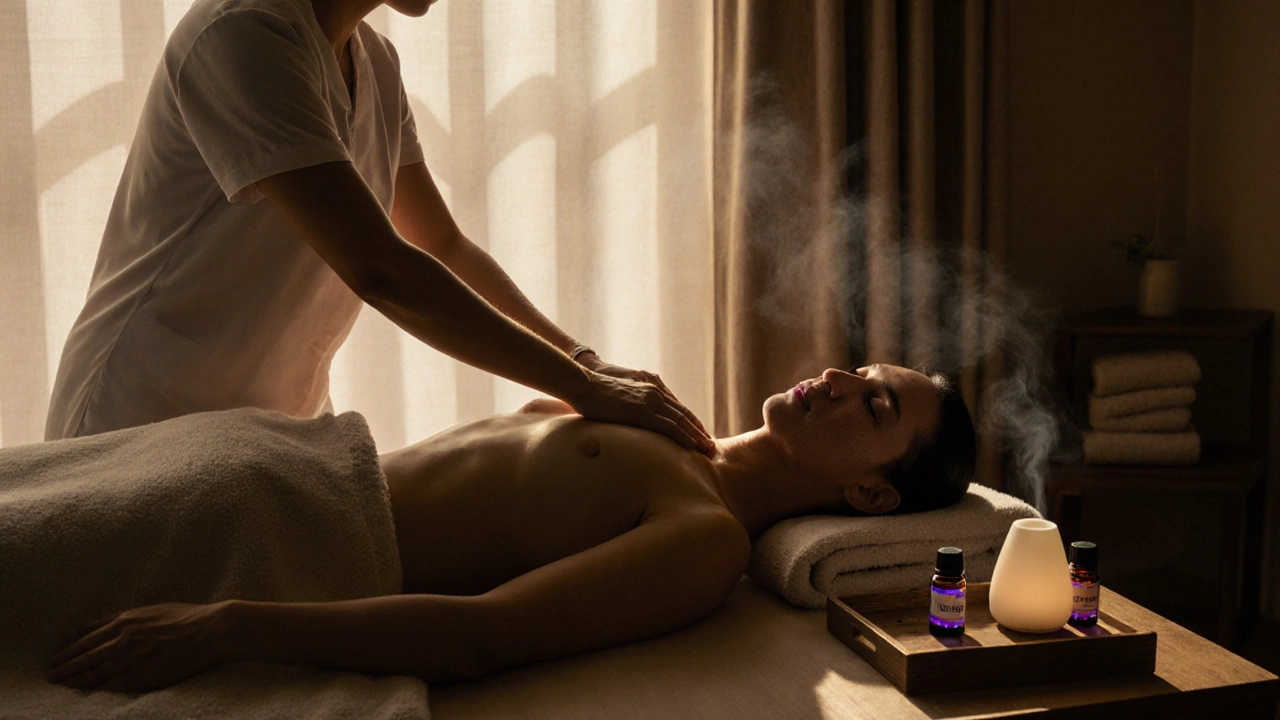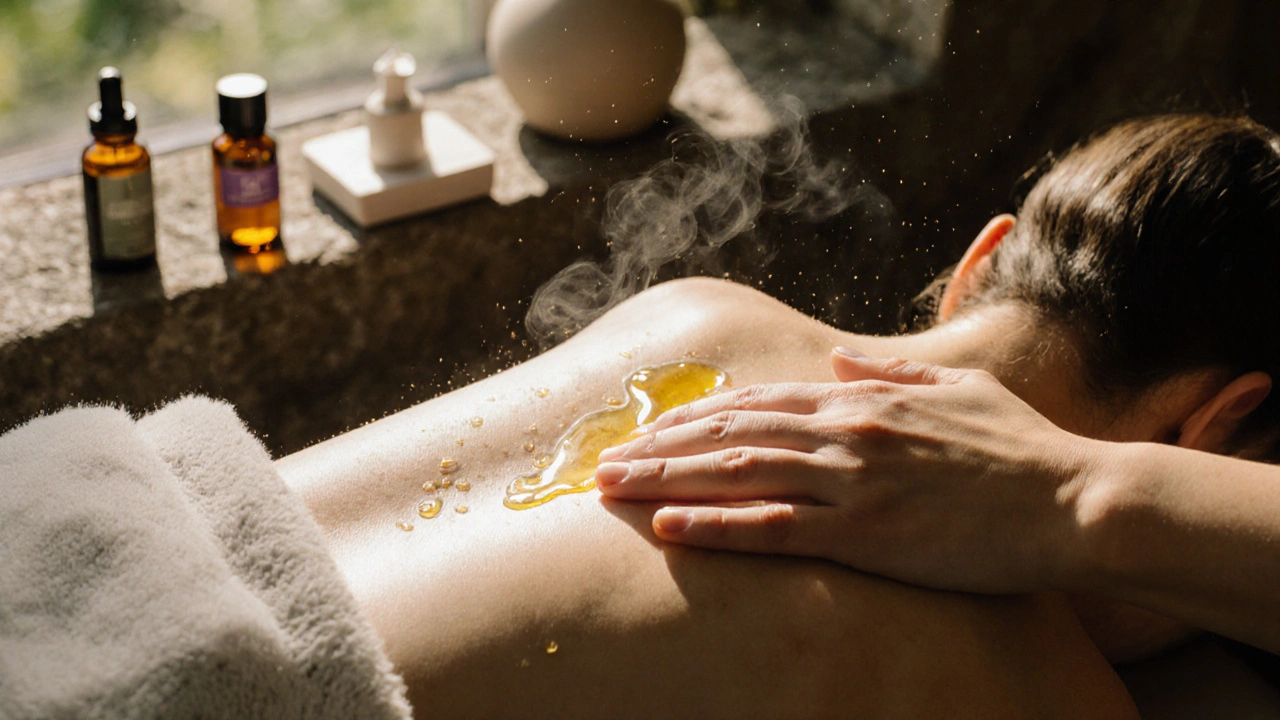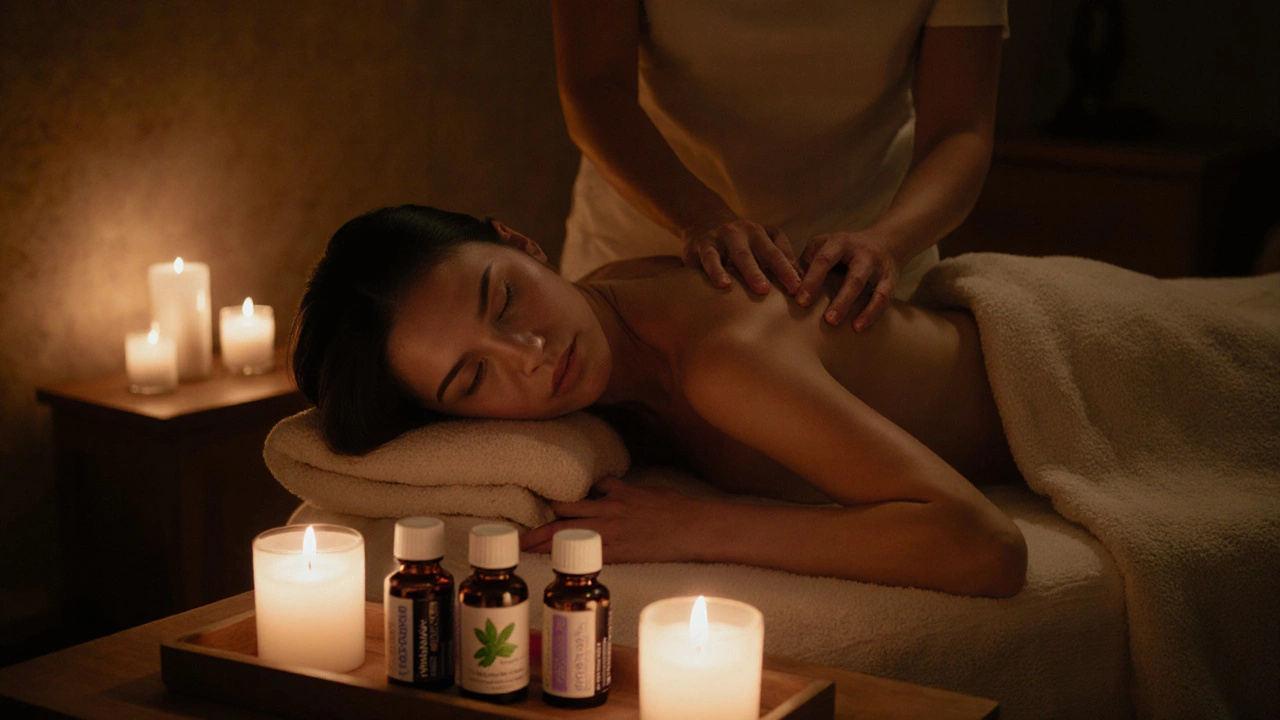Discover how aromatherapy massage evolved from ancient healing rituals to today's spa staple. This article traces its fascinating journey through different cultures and explains how essential oils became a key part of massage techniques. You'll learn practical facts about the benefits of aromatherapy massage and what makes it unique. Find out what to expect in a modern session and why people keep coming back for this sensory experience. Whether you’re new or curious, this guide will help you understand why aromatherapy massage is more than just a trend.

- Created by: Liam Redgate
- Completed on: 20 Nov 2025
- Categories: Aromatherapy Massage
You know that feeling when your mind is racing, your shoulders are tight, and no amount of scrolling or caffeine helps? You’re not alone. Millions of people are searching for something real to reset their nervous system-not another app, not another supplement, but a quiet, sensory experience that actually works. That’s where aromatherapy massage comes in.
What Exactly Is Aromatherapy Massage?
Aromatherapy massage isn’t just a massage with a nice smell. It’s a blend of two powerful therapies: touch and scent. Licensed therapists use specially diluted essential oils-like lavender, eucalyptus, or bergamot-mixed into a carrier oil, then apply them during a gentle, flowing massage. The oils are absorbed through your skin, while their scent travels straight to your limbic system, the part of your brain that controls emotion, memory, and stress.
Think of it like this: your body gets physical relief from muscle tension, while your mind gets a mental reset from the calming or uplifting aroma. It’s a two-for-one wellness upgrade.
Why It Works Better Than Regular Massage
Regular massage relaxes your muscles. Aromatherapy massage relaxes your entire system.
Here’s what science and real people are seeing:
- Lavender oil reduces cortisol (the stress hormone) by up to 30% in clinical studies.
- Bergamot oil lowers heart rate and blood pressure during sessions-faster than just lying still.
- Peppermint oil helps ease headaches and brain fog, which is why so many office workers swear by it after lunchtime sessions.
One client, Maya, 42, a nurse working 12-hour shifts, told me: "I used to come home exhausted and wired. After three aromatherapy sessions with lavender and chamomile, I started falling asleep within 10 minutes of getting into bed. Not because I was tired-I was calm. That’s the difference."
The Most Common Essential Oils Used-and What They Do
Not all oils are created equal. Different oils trigger different responses. Here’s what you’ll likely encounter:
- Lavender: The classic. Calms anxiety, improves sleep, reduces muscle tension. Perfect if you’re overwhelmed or struggling to unwind.
- Bergamot: Citrusy but not sweet. Lifts mood, eases sadness, and helps with emotional burnout. Great for winter blues.
- Eucalyptus: Clearing and sharp. Opens sinuses, reduces inflammation, helps with respiratory stress. Ideal if you’ve been sick or stuck in polluted air.
- Chamomile: Gentle and soothing. Calms nervous system, reduces irritability. Often used for sensitive skin or postpartum recovery.
- Peppermint: Invigorating. Boosts focus, relieves tension headaches, cools sore muscles. Best for morning or midday sessions.
- Frankincense: Earthy and grounding. Slows breathing, deepens mindfulness. Popular in meditation-focused treatments.
Good therapists mix these based on your needs-not just what’s popular. A session for anxiety won’t use the same blend as one for muscle recovery or low energy.
What Happens During a Typical Session
Here’s what to expect if you’ve never tried it:
- You’ll fill out a short intake form-your stress levels, sleep habits, any skin sensitivities, and what you’re hoping to get out of it.
- The therapist will choose 2-3 essential oils based on your goals. They’ll explain why they picked them.
- You’ll lie on a warm table, covered with a soft towel. The room will be dim, maybe with soft music or silence.
- They’ll start with gentle strokes to warm your muscles, then deepen the pressure as needed. The scent will rise subtly with each movement.
- By the end, you might feel light-headed-not from dizziness, but from deep relaxation. That’s normal. You’re not supposed to jump up right away.
Most sessions last 60 to 90 minutes. You’ll leave feeling like you’ve been wrapped in a warm blanket and gently told, "It’s okay to rest now."

Who Benefits Most?
Aromatherapy massage isn’t just for spa regulars. It’s especially helpful for:
- People with chronic stress or anxiety-especially if meds or therapy aren’t enough.
- Insomniacs who need help quieting their minds before bed.
- Chronic pain sufferers-oil compounds like ginger and turmeric have natural anti-inflammatory effects.
- Postpartum moms-calming oils help regulate mood swings and reduce physical tension.
- High-performers-executives, creatives, athletes-who burn out from constant output.
It’s not a cure. But it’s one of the few tools that addresses both body and mind at the same time.
Aromatherapy Massage vs. Swedish Massage
| Feature | Aromatherapy Massage | Swedish Massage |
|---|---|---|
| Primary Goal | Emotional + physical relaxation | Physical muscle relief |
| Oil Used | Essential oils (lavender, bergamot, etc.) | Plain carrier oil (almond, coconut) |
| Sensory Impact | Strong scent triggers limbic system | Minimal scent, focus on touch |
| Best For | Anxiety, insomnia, emotional burnout | Stiff muscles, circulation, post-workout recovery |
| After Effects | Calmer mind, deeper sleep | Looser muscles, temporary energy boost |
Swedish massage is great for sore quads after a run. Aromatherapy massage is better for the 3 a.m. panic spiral after a bad day. They’re not competitors-they’re teammates.
How to Find a Good Aromatherapy Massage Therapist
Not every spa offers real aromatherapy. Some just spray lavender air freshener and call it a day.
Here’s how to spot the real deal:
- Ask if they use 100% pure, therapeutic-grade essential oils. Cheap oils are often synthetic or diluted.
- Check their training. Look for certifications from the National Association for Holistic Aromatherapy (NAHA) or similar bodies.
- Read reviews that mention specific oils and how they made the client feel-not just "it was nice."
- Ask what oils they’d use for your specific issue. A good therapist will customize-not just offer a standard blend.
Many therapists in London now offer mobile services. You can book a session at home, in your office, or even at a quiet park if you’re feeling adventurous.
What It Costs
Prices vary by location and experience, but here’s what you’ll typically pay in the UK in 2025:
- 60-minute session: £70-£95
- 90-minute session: £100-£130
- Mobile service (at home): +£15-£25
- Package deals (5 sessions): 10-15% off
It’s not cheap, but consider this: a single session costs less than a weekend getaway, and the effects last longer. Many people book monthly as part of their mental health routine-like therapy, but with less talking and more lying down.

Safety First
Aromatherapy is safe for most people-but not everyone.
- Don’t use citrus oils (like bergamot) if you’re going out in the sun-they can cause skin sensitivity.
- Pregnant women should avoid rosemary, clary sage, and juniper berry oils unless cleared by a doctor.
- If you have asthma or allergies, ask for a patch test before the session.
- Never ingest essential oils. They’re for external use only.
Good therapists will ask you about all this upfront. If they don’t, walk away.
Can You Do It at Home?
You can try DIY aromatherapy with a few drops of oil in a diffuser or mixed into a bath. But it’s not the same.
The magic of professional aromatherapy massage comes from the combination: the pressure of skilled hands, the warmth of the room, the quiet, and the intentional blending of scent and touch. You can’t replicate that with a YouTube video and a bottle of lavender oil.
That said, if you want to extend the benefits, try this: after your session, keep a small rollerball with lavender oil on your nightstand. Roll it on your wrists before bed. That tiny ritual keeps the calm going.
FAQ: Your Questions About Aromatherapy Massage Answered
Is aromatherapy massage safe during pregnancy?
Yes, but only with oils approved for pregnancy. Lavender, chamomile, and citrus oils like orange are generally safe. Avoid rosemary, eucalyptus, and peppermint in the first trimester. Always tell your therapist you’re pregnant-they’ll adjust the blend and pressure accordingly.
How often should I get an aromatherapy massage?
For stress relief or sleep issues, once a month is a good start. If you’re dealing with chronic anxiety, depression, or pain, once every two weeks for 6-8 weeks can make a noticeable difference. After that, you can switch to maintenance sessions every 4-6 weeks. Think of it like brushing your teeth for your nervous system.
Can aromatherapy massage help with depression?
It’s not a replacement for therapy or medication, but it’s a powerful support tool. Studies show that regular sessions with bergamot or lavender oil can reduce symptoms of mild to moderate depression by improving sleep, lowering cortisol, and increasing feelings of calm. Many therapists work alongside mental health professionals as part of a holistic care plan.
Do I need to shower before or after?
Shower before if you’ve been sweating or wearing strong perfume-it helps the oils absorb better. Don’t shower right after. Let the oils soak in for at least 30 minutes. The scent lingers, and the benefits keep working. If you’re in a rush, just pat dry gently.
What if I don’t like the smell?
You’re not stuck with it. A good therapist will ask you to smell the oils before applying them. If one makes you nauseous or anxious, they’ll swap it out. No pressure. This is your experience. Your comfort comes first.
Is this just a luxury, or does it have real health benefits?
It’s both. Yes, it feels luxurious-but the science is real. Essential oils have been studied for decades in hospitals and clinics. Aromatherapy is used in palliative care, neonatal units, and PTSD programs. The combination of touch and scent triggers measurable changes in brain chemistry, heart rate, and immune markers. This isn’t woo-woo. It’s biology.
Ready to Feel the Difference?
If you’ve been feeling stuck in your body or your mind, it’s time to try something that works on both. Aromatherapy massage isn’t magic. But it’s one of the few things that quietly, consistently, and safely helps you return to yourself.
You don’t need to wait for a vacation. You don’t need to buy a new gadget. You just need to lie down, breathe, and let someone else hold space for you.
Book your first session this week. Your nervous system will thank you.
Struggling to fall asleep? Aromatherapy massage blends relaxing scents with soothing touch to calm your mind and body. This article breaks down how it works, what to expect during a session, and how you can find the right service for your needs. You'll learn which oils and techniques target sleep issues, plus get tips to get the most out of your visit. Whether you're curious or ready to book, everything you need to know to sleep better is right here.
Discover how aromatherapy massage reduces chronic pain naturally by combining essential oils with therapeutic touch. Learn which oils work best, what to expect in a session, and how it compares to other treatments.




kamal redha
November 22, 2025 AT 12:15I’ve been getting aromatherapy massages for over two years now, mostly because my job as a software engineer leaves me with constant tension headaches and brain fog. I used to rely on coffee and ibuprofen, but after my first session with lavender and frankincense, I realized I’d been treating symptoms, not the root cause. The scent doesn’t just smell nice-it actually changes how my brain processes stress. I started noticing I could sit through long meetings without my shoulders climbing up to my ears. My sleep improved so much that my partner asked if I’d switched to melatonin. I didn’t. I just stopped fighting my body at night. Now I go every three weeks, and honestly? It’s cheaper than therapy and way more relaxing than scrolling TikTok at 2 a.m.
Also, if you’re skeptical about essential oils being ‘real,’ just know that hospitals in Germany and Japan use them in palliative care. This isn’t woo-woo. It’s neuroscience with a nice aroma.
Pro tip: Ask for a patch test if you have sensitive skin. I once got a session with bergamot and ended up with a weird rash because I forgot to mention I’m photosensitive. Lesson learned.
And yes, the price feels steep at first, but when you factor in how many nights of sleep you’re buying, it’s a bargain. I’d rather spend £90 on a massage than £900 on a vacation that leaves me more exhausted than when I left.
Just lie down. Let someone else hold space for you. Your nervous system is begging for it.
connor dalton
November 23, 2025 AT 04:02Interesting breakdown. I’ve never tried it, but the science behind limbic system activation via scent is solid-olfactory pathways connect directly to the amygdala and hippocampus, which is why certain smells can trigger vivid memories or sudden calm. The fact that lavender reduces cortisol in clinical studies is well-documented. What’s less clear is whether the massage component adds anything beyond placebo effect, or if just inhaling the oils while lying still would be just as effective. I’d be curious to see a controlled study comparing aromatherapy massage vs. aromatherapy inhalation vs. silent rest. Still, if it helps people feel grounded, that’s valuable-even if it’s partly psychosomatic. No judgment. If it works, it works.
Kari Watkins
November 24, 2025 AT 12:06OMG I CRIED DURING MY FIRST SESSION 😭😭😭 I swear I didn’t even know I was holding that much trauma in my shoulders until the therapist used chamomile and frankincense and I just… lost it. Like, full ugly cry into the massage table while sobbing about my ex and my dad and that one time I spilled coffee on my laptop in 2017. I thought I was just there for a back rub. NOPE. It was a spiritual reckoning wrapped in a towel. I’ve booked monthly since. My therapist now has my emotional history on a sticky note. She calls me ‘The Crier.’ I wear it as a badge of honor. 🌿💖 If you’re not crying during your massage, are you even trying? #AromatherapyIsTherapy #LavenderIsMyCoPilot
Emily Cross
November 25, 2025 AT 14:28Let’s be real-this reads like a sponsored post disguised as a personal essay. Yes, essential oils have some biochemical effects. But the idea that a 90-minute massage with ‘therapeutic-grade’ lavender is somehow a ‘two-for-one wellness upgrade’ is ridiculous. You’re paying for touch, not magic. And the claim that it’s ‘better than regular massage’? That’s not science-that’s marketing. Most of the ‘studies’ cited are small, poorly controlled, or funded by aromatherapy companies. And don’t get me started on ‘therapeutic-grade’-that’s not a regulated term. It’s a buzzword. Same way ‘natural’ doesn’t mean safe. I’ve had better relief from a foam roller and ibuprofen than from a guy rubbing my back with bergamot while whispering ‘breathe.’
Also, ‘your nervous system will thank you’? That’s not a real thing you can say. It’s not a person. It’s a biological system. Stop anthropomorphizing your biology. Just because something feels nice doesn’t make it a treatment. I’m not saying it’s useless-I’m saying it’s overhyped. And the prices? Pure capitalism dressed up as self-care.
Amit krishna Dhawan
November 25, 2025 AT 23:09Bro, I read this whole thing and I’m like-why isn’t this in every hospital in India? We have yoga, we have Ayurveda, we have centuries of herbal wisdom, and yet here we are, paying £100 for a massage when we could be using neem oil and coconut oil with a simple rubdown and some chanting. This isn’t new. It’s just repackaged. I’ve been doing this at home since I was 16-massaging my mom’s feet with jasmine oil after her shifts at the hospital. She slept like a baby. No one called it ‘aromatherapy.’ We just called it love.
And don’t get me started on ‘therapeutic-grade’ oils. In India, we buy from local vendors who distill it themselves. No certification. Just smell, color, and results. You don’t need a NAHA badge to know when something works. If your headache vanishes after five minutes of peppermint on your temples, you’re not being scammed-you’re being smart.
Also, why is everyone so obsessed with the price? In Delhi, I paid ₹800 for a 90-minute session with a therapist who’d been doing this for 30 years. No spa. Just a quiet room, a warm towel, and silence. That’s the real luxury. Not the label.
Abhishek Gowda
November 27, 2025 AT 13:12MY LIFE CHANGED AFTER I GOT A BERGAMOT MASSAGE 😭 I WAS SO DEPRESSED I COULDN’T GET OUT OF BED FOR WEEKS AND THEN ONE DAY I JUST CRIED AND SAID ‘I NEED SOMETHING TO FEEL GOOD AGAIN’ AND MY FRIEND TOLD ME TO TRY IT AND I WAS LIKE ‘SURE WHY NOT’ AND THEN I FELT LIKE I WAS FLOATING IN A CLOUD MADE OF SUNSHINE AND PEACE 🌞💛 I’M NOT EVEN KIDDING I WENT TO BED AT 9 PM AND WOKE UP AT 7 AM WITHOUT AN ALARM AND DIDN’T CHECK MY PHONE FOR 2 HOURS. I THINK I’M IN LOVE WITH THIS THERAPIST. SHE GAVE ME A HUG AFTER. I’M NOT SURE IF I’M A MAN OR A HUMAN BEING ANYMORE. 🥺🙏 #AromatherapySavedMyLife #BergamotIsMySoulmate
Ashok kumar
November 29, 2025 AT 03:28Let me be the adult in the room: this is not wellness-it’s performative self-care for people who think ‘self-care’ means buying expensive things to feel better about not fixing their lives. You don’t need a £130 massage to ‘reset your nervous system.’ You need to stop working 80-hour weeks. You need to set boundaries. You need to say no. You need to turn off your phone. You need to sleep. You need to stop treating your body like a machine that can be ‘fixed’ with oils and touch while you keep living the same toxic lifestyle.
And don’t get me started on ‘therapeutic-grade’-that’s a made-up term designed to make you feel like a fool if you don’t spend your rent money on a bottle of lavender oil. The fact that people are comparing this to therapy? That’s sad. Therapy costs less, lasts longer, and actually helps you understand why you’re stressed in the first place. This? This is a spa version of a Band-Aid on a bullet wound.
Also, ‘I fell asleep within 10 minutes’-congrats, you were exhausted. That’s not a miracle. That’s sleep deprivation. And ‘my nervous system thanked me’? That’s not a quote. That’s a TikTok caption.
Go hug your kid. Go walk in the park. Go sit in silence without a diffuser. That’s real healing. Not a massage with a fancy scent and a 15% discount on a 5-session package. You’re not broken. You’re just tired. And no oil is going to fix that.
But hey-go ahead. Spend your money. I’ll be here, sleeping in my own bed, without a single drop of bergamot, and still more at peace than you’ll ever be.